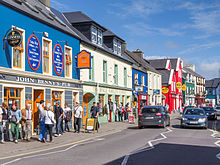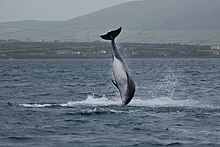Daingean Uí Chúis
Daingean Uí Chúis ([ ˈd̪aŋ´ən iː xuːʃ ], also Irish An Daingean [ ən ˈd̪aŋ´ən ], "the fortress", or English Dingle ) is a place with 2050 inhabitants (2016) on the Dingle Peninsula on a bay of the Atlantic Ocean , in the west of the Republic of Ireland in County Kerry . Although the place is in the Irish-speaking Gaeltacht , where only the Irish place names have had official status since 2003, the English-speaking name has also been (again) official since 2011, following demands from the population.
City history

It is not known when Dingle became a city. In 1607 the city was given a statute by King James I , which granted the city rights promised by Queen Elizabeth I of England in 1585, so that Dingle as a city is only 405 years old. However, the place was settled much earlier, long before the king granted town charter. Her Gaelic name is Daingean Ui Chúis or O'Cush's fortress. The fact that there is no record of the O'Cush clan led to the assumption that the name is a mutilation of Hussey or Huysse, a Flemish family who came here in the 13th century. In a document from 1290, the name of the city is given as Dengynhuysse. In the Middle Ages there were three castles within the city, probably just Tower Houses, all of which were grouped near what is now the corner of Green Street and Main Street : Hussey Castle , Rice Castle and the place where the library is today, stood earlier the Caisleán na bhFiach , which was long owned by the Knights of Kerry .
When Norman settlers arrived in the 13th century, Dingle quickly developed into a trading port for butter , wool , hides, fish and meat and as an import center for coal , salt , clothing and wine . It was an Irish trading center until the 14th century, particularly in exchange with Spain and France . During the Desmond Rebellions between 1569 and 1583, the Spanish role went beyond that of a trading partner, as Catholic Spanish troops allied with the Catholic Irish rebels against the Protestant English. Their intervention was unsuccessful and almost the entire Spanish and papal Italian army was killed by the English in the Smerwick Bay, west of Dingle, in Fort del Oro (Smerwick Castle), in a ring fort Dún An Óir in the so-called Smerwick Massacre of 1580 . The Earl of Ormond (Black Earl) killed men, women and children, took the livestock and destroyed the crops and houses on the peninsula.
Sightseeing and tourism
Because of the scenic advantages, the economy is characterized by tourism . Dingle is about 30 km west of Tralee and can be easily reached by bus or car in around 45 minutes. The west of the peninsula is a Gaeltacht area, many residents speak Irish - a Gaelic or Celtic language.
Numerous pubs, sea food restaurants and craft shops offer a lot of traditional and tourist attractions. Dick Mack's in particular is known worldwide and popular with tourists, as the restaurant is both a pub and a shoemaker's workshop, which combines the pub air with the smell of leather. However, it is particularly important to note the enormous density of archaeological sights on the Dingle Peninsula. The peninsula is and was also home to many, mostly Irish-speaking poets and writers .
Tours in the surrounding area are ideal for day trips. Worth seeing include the Connor Pass (the highest pass in Ireland) and Slea Head, a steeply sloping cliff in the west of the peninsula. Also in the west of the peninsula is the westernmost town in Ireland - Dún Chaoin . From Dún Chaoin it is also worth taking a fishing boat to Great Blasket Island .
The most famous local or "native" thingle is the dolphin "Fungie", who has declared Dingle Bay to be his home since 1984 and is now one of the main tourist attractions. Numerous fishermen offer trips to "Fungie".
Twin cities
Dingle has partnerships with the following cities:
sons and daughters of the town
- John McDonald (1837-1917), American politician
- Michael Joseph Keyes (1876–1959), Bishop of Savannah
- Michael Begley (1932–2012), politician
- Josie Knight (* 1997), cyclist
Film set
Before the tourists began to discover Dingle for themselves, the small town experienced its first economic boom when the entire staff of the film Ryan's Daughter (original title: Ryan's Daughter , 1970) stayed here for months at the end of the 1960s . The epic film was shot in various locations across the west coast of Ireland, but the filmmakers chose the picturesque village of Dingle as their headquarters. The city still lives on the fame today; especially at the International Dingle Film Festival which showcases Irish avant-garde films, Gaelic-language works and international art films.
Even Ron Howard discovered in 1992 for his film Far and Away with Tom Cruise and Nicole Kidman the peninsula. The beginning of the film was filmed here and on the blaskets .
Literary backdrop
The plot of the novel The Last of its Kind by Andreas Eschbach takes place in Dingle. The protagonist describes the place in the first person in a detailed way.
literature
- Steve Mac Donogh: The Dingle Peninsula. Brandon Books, 1993, ISBN 0-86322-159-9 .
Web links
supporting documents
- ↑ To Daingean (Town) on citypopulation.de, August 5, 2017, accessed on August 5, 2017
- ^ Local Government Act 2001 - Revised. Law Reform Commission / Coimisiún um Athchóiriú an Dlí, October 22, 2018, accessed on December 6, 2018 : “The townland […] known […] as An Daingean shall […] be known, in the Irish language, as Daingean Uí Chúis and, in the English language, as Dingle. "
- ↑ (Engl.) History of the Dingle Peninsula ( Memento of the original on 21 March 2007 at the Internet Archive ) Info: The archive link is automatically inserted and not yet tested. Please check the original and archive link according to the instructions and then remove this notice.
- ↑ KE043-224004: Hussey Castle (Dingle)
- ↑ KE043-224002: Rice Castle (Dingle)
- ↑ KE043-224003: Caisleán na bhFiach (Dingle)
- ↑ Dún An Óir (Fort del Oro) on www.voicesfromthedawn.com ; accessed on June 16, 2017.
- ↑ Dún An Óir on www.megalithicireland.com ; accessed on June 16, 2017.
- ↑ Video: Fungie accompanies a boat
- ↑ City of Santa Barbara: Sister Cities
- ^ Dingle Film Festival
Coordinates: 52 ° 8 ′ N , 10 ° 16 ′ W


